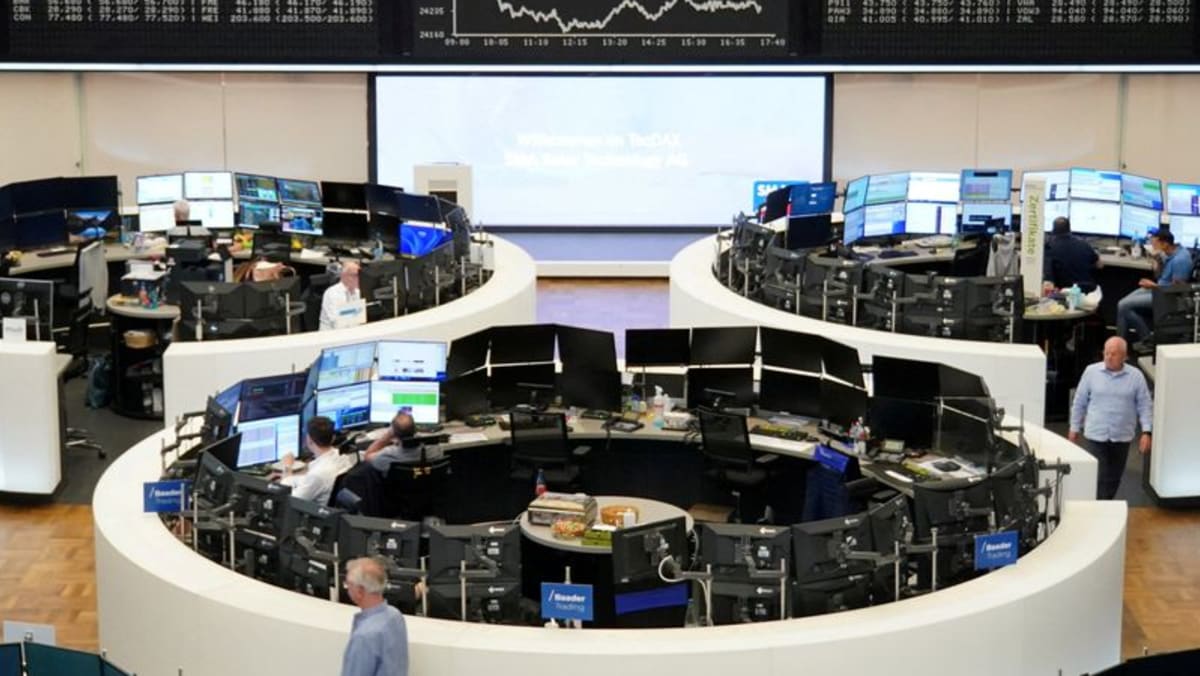NEW YORK, LONDON :A global equities gauge fell on Monday while the euro took a tumble and U.S. Treasuries sold off as investors cautiously greeted a trade agreement between the U.S. and European Union at the start of an action-packed week for markets.
The weekend’s framework trade deal, which European Commission President Ursula von der Leyen described as the best the bloc could get, will impose a 15 per cent import tariff on most EU goods while the EU is set to spend $600 billion on U.S. investments and open up some important parts of its market.
While the accord may avert a damaging standoff between the trading partners, which account for almost a third of global trade, some European capitals complained it was lopsided in favor of Washington.
“The brunt of it is being felt by the euro because when you really step back, Europe gave up a lot. Relatively speaking, the U.S. didn’t give up anything,” said Jack Janasiewicz, portfolio manager at Natixis Investment Managers Solutions.
Equity investor enthusiasm over the trade deal likely faded as market participants looked into the details and questioned how Europe’s requirement for spending on U.S. defense and energy would be enforced, Janasiewicz added.
MSCI’s gauge of stocks across the globe fell 2.78 points, or 0.30 per cent, to 938.48. The index, representing stocks from 47 countries, had boasted five record closes out of the prior six trading sessions.
Monday’s tepid equity action followed a series of record highs for the S&P 500 and Nasdaq, thanks to solid quarterly earnings and bets on megacaps and artificial intelligence stocks as well as optimism that the U.S. would ultimately reach agreements with its trading partners.
On Wall Street the 500 barely managed to squeak another record close, its sixth in a row, by finishing up 1.13 points, or 0.02 per cent, at 6,389.77.
The Nasdaq Composite also managed a record close with a gain of 70.27 points, or 0.33 per cent, to 21,178.58. The Dow Jones Industrial Average fell 64.36 points, or 0.14 per cent, to 44,837.56, still short of its early December record close.
Earlier, the pan-European STOXX 600 index closed down 0.22 per cent, while Europe’s broad FTSEurofirst 300 index fell 0.15 per cent.
Phil Orlando, chief market strategist at Federated Hermes, said that removing uncertainty was a relief along with the 15 per cent tariff rate, which was lower than some of “the ridiculous numbers” being talked about in early April.
“You’ve got some certainty going forward, and you’ve got numbers that seem reasonable,” he said.
Orlando said investors should be patient since the S&P 500 had already risen about 32 per cent from its April lows. He pointed to U.S. inflation and payroll reports and a U.S. Federal Reserve meeting all due in the week ahead, along with earnings reports from megacaps including Apple, Microsoft and Amazon.
Europe’s agreement follows U.S. pacts with Japan, Indonesia and the Philippines made last week. Other countries were still scrambling to make deals ahead of U.S. President Donald Trump’s August 1 deadline.
Top U.S. and Chinese economic officials met in Stockholm on Monday for more than five hours of talks aimed at resolving longstanding economic disputes at the centre of a trade war between the world’s top two economies, seeking to extend a truce by three months.
In currencies, the dollar rose against major currencies after the weekend’s trade pact, with investors also looking to this week’s U.S. and Japanese central bank meetings.
The euro was down 1.27 per cent at $1.1591. Against the Japanese yen , the dollar strengthened 0.62 per cent to 148.57.
The dollar index <=USD>, which measures the greenback against a basket of currencies including the yen and the euro, rose 1.07 per cent to 98.65.
In U.S. Treasuries, yields rose following the trade deal and U.S. bond auctions. The next U.S. Federal Reserve policy meeting kicks off on Tuesday and the Fed is not expected to change interest rates this week. The central bank has been cautious on rate cuts as officials want to determine the impact of tariffs on inflation before making decisions.
The yield on benchmark U.S. 10-year notes rose 2.8 basis points to 4.414 per cent, from 4.386 per cent late on Friday while the 30-year bond yield rose 3.3 basis points to 4.9616 per cent.
The 2-year note yield, which typically moves in step with interest rate expectations for the Federal Reserve, rose 1.1 basis points to 3.928 per cent.
In energy markets, oil prices rallied more than 2 per cent after the U.S.-EU deal and Trump’s announcement that he would shorten the deadline set for Russia to end its war in Ukraine or face severe tariffs.
U.S. crude settled up 2.38 per cent or $1.55, at $66.71 per barrel while Brent finished at $70.04 per barrel, up 2.34 per cent, or $1.60 on the day.
In precious metals, gold fell to a near three-week low as the trade accord lifted the dollar and risk sentiment, while investors awaited fresh cues on rate policy from this week’s Fed meeting.
Spot gold fell 0.56 per cent to $3,317.31 an ounce. U.S. gold futures fell 0.74 per cent to $3,309.20 an ounce.
